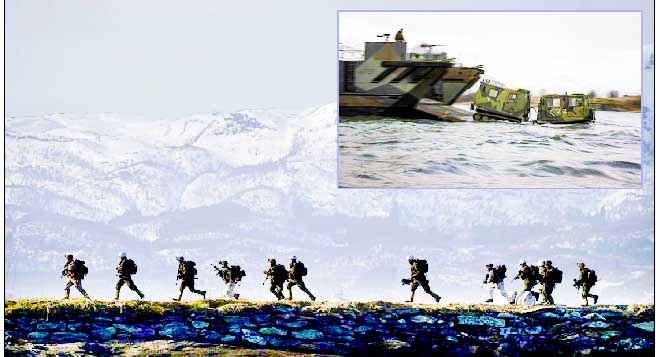
BSS :
Thousands of NATO troops, some with little experience of operating in snowy conditions, are learning to survive and fight in freezing temperatures in exercises above the Arctic Circle.
Up in Norway’s Far North, a group of US Marines have swapped their usual desert camouflage outfits for mountain gear, thick mittens and big white boots.
It is a world away from the hot and humid climate of their home base of Camp Lejeune in North Carolina.Lying in the snow on the roadside, the men and women of the Marines 2nd expeditionary force are keeping an eye on a fictitious enemy.
They’re providing cover for an extensive landing operation on the shore down the hill.
One after another, amphibious Snowcats emerge from the belly of the Rotterdam, a mammoth Dutch landing vessel. Once on the beach, each one in turn unloads tracked vehicles and other military equipment.
“If a unit can train and win in the Arctic, I believe they can win anywhere”, says Sergeant Samuel Whitehead.But here, more than anywhere, he adds, the smallest mistake can have dire consequences.
A few days earlier, four US Marines were killed during the exercise in a plane crash in mountainous terrain, a harsh reminder of the risks of operating in challenging weather conditions.
This month’s Cold Response 2022 exercise in Norway is aimed at testing the ability of NATO members — and non-members Sweden and Finland — to come to the aid of another member state in difficult climate conditions.
Some 30,000 troops are taking part in the air, sea and land exercises, the biggest manoeuvres Norway has organised since the end of the Cold War.
Planned long in advance, the exercise has taken on added significance following Russia’s invasion of Ukraine.
The message we are sending, one US marine confided, is: Don’t mess with us — though he found a blunter way of putting it.
“Many soldiers have been here several times over the years, so they have the right equipment, they have the understanding and the experience … to fight under winter conditions,” says German General Jorg Vollmer, tasked with securing NATO’s Northern flank.
“And those who have not had the chance so far, that’s exactly the reason why they are here and why they are training”, he adds.In contrast to the dramatic scenes often played out in war films, the only spectacular thing about today’s landing operation is the scenery.

